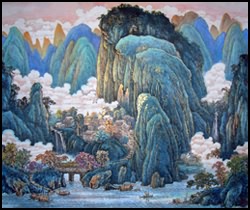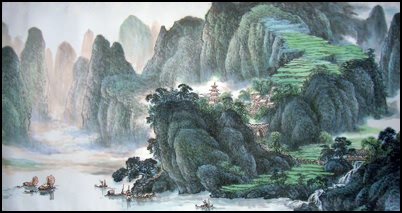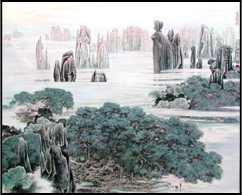China Painting Knowledge
- Chinese Painting Introduction
- Chinese Painting Types
- Chinese Calligraphy Art
- Chinese Painting Techniques
- Equipment and Materials
- Chinese Painting Mounting
- History of Chinese Painting
- Landscape Painting Introduction
- Mountain & Rock Painting
- Water & Waterfall Painting
- Trees & Bamboo Painting
- Chinese Fisherman Painting
- Building and People Painting
- History of Landscape Painting
- Flower Painting Introduction
- Chinese Narcissus Painting
- Chinese Lotus Painting
- Chinese Peony Painting
- Chinese Leaves Painting
- the Four Gentlement Painting
- History of Flower Painting
- Figure Painting Introduction
- How to paint figure
- History of Figure Painting
- Animal Painting Introduction
- Chinese Fish Painting
- Chinese Dragon Painting
- Chinese Insect Painting
- Chinese Tiger Painting
- Chinese Bird Painting
- Chinese Horse Painting
- History of Animal Painting
- Equipment and Materials
- The Four Treasures of Studio
- Chinese Painting Brushes
- The Ink Stone & Ink Stick
- The Painting Surface
HOME > China Painting Knowledge
Chinese brush painting has its origins in the distant past. Some of the  earliest paintings were of figures on funeral banners and illustrations of everyday life commemorated on cave and tomb walls, complete with possessions. The sizes of the paintings varied, along with the amount of detail portrayed. Above all, Chinese artists followed their own inclination, ignoring ideas from the West, such as perspective, and absorbing the culture of their conquerors. In their turn they had an impact on neighboring areas, such as Korea, Malaysia, and Japan. Their religions, superstitions, and beliefs were reflected in their paintings and motifs.
earliest paintings were of figures on funeral banners and illustrations of everyday life commemorated on cave and tomb walls, complete with possessions. The sizes of the paintings varied, along with the amount of detail portrayed. Above all, Chinese artists followed their own inclination, ignoring ideas from the West, such as perspective, and absorbing the culture of their conquerors. In their turn they had an impact on neighboring areas, such as Korea, Malaysia, and Japan. Their religions, superstitions, and beliefs were reflected in their paintings and motifs.
 Since these early times, the Chinese have looked to the work of the past, copying the “masters” in order to learn. The extent to which each master copied earlier works is a matter of debate. But each artist is capable of adding something of themselves, even when looking back to the past masters’ techniques and styles. It is easy to mistake a painting from the 9th or 10th century for a modern version.
Since these early times, the Chinese have looked to the work of the past, copying the “masters” in order to learn. The extent to which each master copied earlier works is a matter of debate. But each artist is capable of adding something of themselves, even when looking back to the past masters’ techniques and styles. It is easy to mistake a painting from the 9th or 10th century for a modern version.
Chinese or Oriental composition is quite different to Western approaches to art. The Oriental style tries to capture a “moment in time,” which might include only part of a larger subject. The Western world generally takes an overall view of a subject, and is not so likely to abbreviate a picture. The Oriental way of presenting a picture, its frame and preservation, are quite at odds with Western concepts. In the West we have a feeling of permanence rather than transience. Paper, and therefore scroll paintings, were not considered or expected to be long-lasting by the Chinese. It is only in recent years that paintings have been deliberately preserved. ...(more)
rather than transience. Paper, and therefore scroll paintings, were not considered or expected to be long-lasting by the Chinese. It is only in recent years that paintings have been deliberately preserved. ...(more)
 earliest paintings were of figures on funeral banners and illustrations of everyday life commemorated on cave and tomb walls, complete with possessions. The sizes of the paintings varied, along with the amount of detail portrayed. Above all, Chinese artists followed their own inclination, ignoring ideas from the West, such as perspective, and absorbing the culture of their conquerors. In their turn they had an impact on neighboring areas, such as Korea, Malaysia, and Japan. Their religions, superstitions, and beliefs were reflected in their paintings and motifs.
earliest paintings were of figures on funeral banners and illustrations of everyday life commemorated on cave and tomb walls, complete with possessions. The sizes of the paintings varied, along with the amount of detail portrayed. Above all, Chinese artists followed their own inclination, ignoring ideas from the West, such as perspective, and absorbing the culture of their conquerors. In their turn they had an impact on neighboring areas, such as Korea, Malaysia, and Japan. Their religions, superstitions, and beliefs were reflected in their paintings and motifs. Since these early times, the Chinese have looked to the work of the past, copying the “masters” in order to learn. The extent to which each master copied earlier works is a matter of debate. But each artist is capable of adding something of themselves, even when looking back to the past masters’ techniques and styles. It is easy to mistake a painting from the 9th or 10th century for a modern version.
Since these early times, the Chinese have looked to the work of the past, copying the “masters” in order to learn. The extent to which each master copied earlier works is a matter of debate. But each artist is capable of adding something of themselves, even when looking back to the past masters’ techniques and styles. It is easy to mistake a painting from the 9th or 10th century for a modern version.
Chinese or Oriental composition is quite different to Western approaches to art. The Oriental style tries to capture a “moment in time,” which might include only part of a larger subject. The Western world generally takes an overall view of a subject, and is not so likely to abbreviate a picture. The Oriental way of presenting a picture, its frame and preservation, are quite at odds with Western concepts. In the West we have a feeling of permanence
 rather than transience. Paper, and therefore scroll paintings, were not considered or expected to be long-lasting by the Chinese. It is only in recent years that paintings have been deliberately preserved. ...(more)
rather than transience. Paper, and therefore scroll paintings, were not considered or expected to be long-lasting by the Chinese. It is only in recent years that paintings have been deliberately preserved. ...(more) 